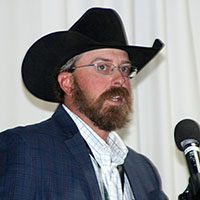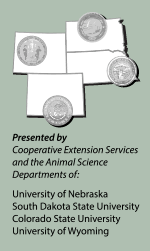Producer Perspective on
Reproductive Technologies
South Dakota cattleman shares viewpoints on reproductive technology use.
LOVELAND, Colo. (Nov. 17, 2015) — “Technology allows us to be a least-cost, value-added producer. We were able to expand the ranch and bring in the next generation without sacrificing,” explains Chad Blair of Blair Brothers Angus Ranch near Sturgis, S.D. The young producer first attended a Range Beef Cow Symposium when he was 12 years old. He returned as a presenter to this year’s event in Loveland, Colo., Nov. 17-19.

Chad Blair of Blair Brothers Angus Ranch near Sturgis, S.D.
The Blairs first started using timed artificial insemination (TAI) in the early 2000s. After trial and error, they settled into using the 14-day CIDR® protocol for heifers because it tightens up the second cycle and results in a 70%-75% conception rate in 28 days. For heifers, he said, they use Kamar heat detection patches.
The ranch started using AI on cows in the early 1990s, when there weren’t many TAI protocols, he notes. Natural heat detection was time-consuming and tedious. More recently, they’ve had good results with Select-Synch + CIDR + TAI on their cows. He added that CIDRs allow them to set up multiple groups of cows in the same week, and breed 3.5 times the number of cows compared to breeding on natural heats with the same amount of labor and time.
Select Synch required them to detect heat prior to administering progesterone. It was a cheaper option, but not as time-efficient with multiple groups, he admitted.
About 77%-87% of the group breed by AI in 25 days in the second cycle. The range depended on cow age because it was more challenging with the younger females.
Blair Brothers Angus Ranch also uses ultrasound technology. They bought their own machine, an Ibex Pro, and learned how to use it themselves. Their machine is battery-operated and dust- and water-resistant, which lets them pregnancy-check when and where they need to. They check pregnancy at 110 days. This lets them get a good read on those second-cycle females that would be 80-days pregnant. They ID their late calvers by dying the hair on the shoulder, which makes them easy to find and sort. Early detection of pregnancy gives them a better strategy for marketing.
With their estrus-synchronization program, their heifers generally calve within 22 days and cows calve within 32 days. The synchronization allows them to plan for how many females should calve at a certain time. This lets them move up to the barn when it is time to calve, which is especially helpful when bad weather is expected.
About half of the first-calf heifers would breed back as 3-year-olds before they started a balanced nutrition program for bred females. Now, with a proper nutrition program, they get 65% of heifers to breed in the first cycle, and 10% more in the second.
He iterated the advantages of synchronizing their females. It limits the amount of labor required. Continual calving makes for a hard month, but they lose fewer calves because that is their focus. It also gives them large groups of same-age calves, which improves their vaccination effectiveness. The cows are at appropriate days postpartum to continue in their system.
The Blairs have tried embryo transfer (ET) technology, but their results did not align with their goals. They are currently trying to expand their numbers, so they keep more heifers to breed and AI.
They tried in vitro fertilization for the first time in 2015. Blair said it lets them keep cows in production and uses less labor, but he doesn’t have any results yet.
Blair Brothers Angus Ranch isn’t afraid to use new technology, but with careful evaluation, they use the technologies that best align with their goals.
Editor’s Note: This summary was written under contract or by staff of the Angus Journal®, which retains the copyright. To request to reprint this article, contact Shauna Rose Hermel, editor, at 816-383-5270. PowerPoints are posted with permission of the presenter and may not be reproduced in whole or in part without the express permission of the presenter. Angus Journal claims copyright to this web site as presented. We welcome educational venues and cattlemen to link to this site as a service to their audience.
The Angus Journal's coverage of the event is made possible through collaboration with the event committee and sponsorship of LiveAuctions.tv. For questions about this site, or to notify us of broken links, click here. Look for additional coverage in the Angus Journal, the Angus Beef Bulletin, the Angus Journal Daily, the Angus Beef Bulletin EXTRA and Angus TV.


